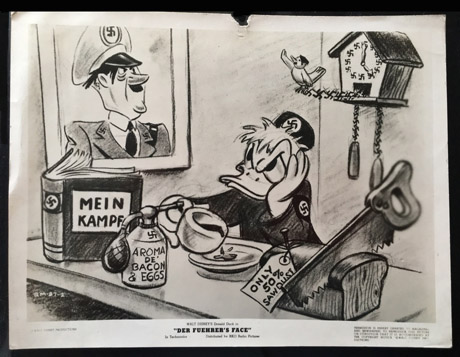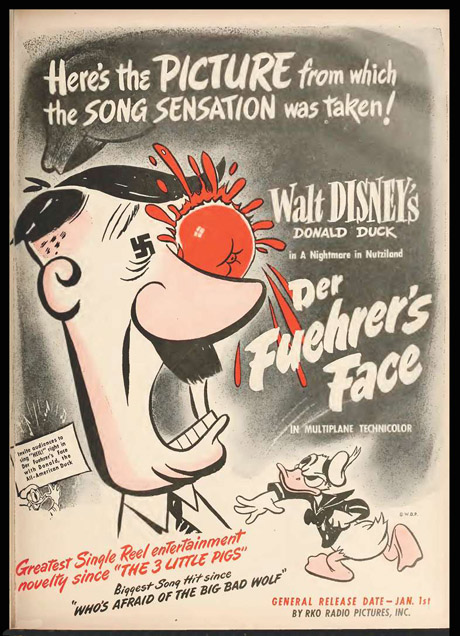
With his short temper and lack of respect for authority, Donald Duck doesn’t seem as if he’d be the first choice to represent the patriotic American soldier during World War II. Despite this, it was precisely the role he played in several short subjects produced at Disney during the War
As America entered World War II in December of 1941, Mickey Mouse’s star began to fade, eclipsed by Donald’s popularity. As Walt and his animators looked to create animated shorts that helped support the War effort, they turned to their most famous foul fowl to star in a number of them.

As author John Baxter wrote in his 2014 book, Disney During World War II: How The Walt Disney Studio Contributed to Victory in the War: “Donald Duck had long been a vicarious outlet for his audiences’ civilized repression of uncivilized urges, and his Army stint would be no different.”
With Memorial Day approaching, we honor and remember those in the military who have sacrificed in their service. It’s the ideal time to look back on this time when so many supported the country’s efforts during World War II.

(1942)
The first of these is, fittingly, Donald Gets Drafted, released on May 1, 1942. As the title suggests, Donald receives his draft notice (and, from it, we learn a bit of Disney trivia when we see that his middle name is Fauntleroy). He enters the Army, which is ironic, as he always has worn a sailor’s suit.
When Donald comes to basic training, he clashes with his drill sergeant (played by Pete), and Donald’s ineptitude throughout the short lands him in KP duty, peeling potatoes, which leads him to spell out his catchphrase “Phooey,” in a potato peel, as the short ends.
Donald Gets Drafted features some comedy jabs at the military, particularly in the scenes during his examination, when Donald mistakes green for blue, and the examiner responds, “Close enough!’
The song in the short “The Army’s Not the Army Anymore” featured music by Leigh Harline and lyrics by Carl Barks. Harline had just won an Oscar for “When You Wish Upon a Star” and the score from Pinocchio. He also contributed to the score for Snow White and the Seven Dwarfs and would later score Mr. Bug Goes to Town for Disney’s rival the Fleischer Studio and also scored such “non-Disney” live-action films as The Road to Utopia (1946) and Mr. Blandings Builds His Dream House (1948).

(1942)
Despite his shortcomings in the Army, Donald’s service continued in The Vanishing Private (1942), where Donald and Pete reprise their roles (and there is even a short return of the song “The Army’s Not the Army Anymore”). In this short, Donald is charged by Pete with camouflaging a cannon when he comes across “invisible paint.” Using this, Donald can make himself and the cannon seemingly disappear to the befuddlement of Pete.
Also released in 1942 was Sky Trooper, once again starring Donald and Pete. In this short, Donald is back on KP duty, once again peeling potatoes. Now, however, he dreams of being a pilot. Sergeant Pete decides to give him a shot at this but dupes Donald into being a paratrooper.
Donald and Pete tumble out of a plane while on a practice flight, along with a bomb that subsequently demolishes the general’s headquarters.

(1943)
Donald was paired back up with Pete for The Old Army Game (also 1943). This time, Donald concocts a plan to sneak off the base for an unauthorized leave. Pete discovers Donald sneaking back onto the base, and the chase is on.
Donald makes it to battle in 1944’s Commando Duck, where he parachutes into the jungle of a Pacific island, with orders to find the enemy and “wipe them out.”
What follows is Donald in some dangerous situations, including Japanese snipers and a precarious waterfall.
With stereotypical depictions of the Japanese, which are offensive, but were commonplace at the time, coupled with the fact that Donald is, at times, in some real life and death situations, Commando Duck has slipped away among the “Donald Army shorts” as a product of its time.
Donald’s civilian life during World War II wasn’t much more manageable. In Donald’s Tire Trouble (1943). The film focuses on the Duck’s issues with a flat tire but references the rubber shortages that were a part of life for many during the War.
Another big part of life on the Homefront was blackouts and Civil Defense. Donald and his nephews Huey, Dewey, and Louie take this on in Home Defense (1943).

However, Donald’s most famous wartime short subject and one that has become an iconic example of Disney’s wartime efforts is Der Fuehrer’s Face (1943).
The short plays out like an animated political cartoon of the era. In it, Donald lives in a caricatured version of Nazi Germany (filled with startling images, such as swastika-shaped clouds). He’s employed in an artillery factory, where he is forced to work faster and faster, which results in a hallucinatory nervous breakdown.
Donald then wakes up to learn that this was all a dream. Hugging a statue of the Statue of Liberty that’s on his windowsill, he declares, “Am I glad to be a citizen of the United States of America!’
Der Fuehrer’s Face won the Oscar for Best Animated Short, and rightly so. It is filled with superb, pointed humor that lampoons and humiliates the (at the time) enemy, which was a goal of many propaganda films.
Jack Kinney, who directed some of Disney’s best-loved short subjects, handles these brilliantly in Der Fuehrer’s Face. Examples are that Donald’s wake-up call for work is a spearing by a bayonet, and he has to “Heil” to portraits of Hitler, Mussolini, and Hirohito, before eating a breakfast of bread so stale that he has to saw it like wood.
At work, Donald is offered a “vacation,” in which he can spend a few minutes in front of a painted backdrop of the Alps.
The song, “Der Fuehrer’s Face” by composer Oliver Wallace was also a big hit during the war, when popular bandleader Spike Jones recorded a version of it.
Der Fuehrer’s Face, due to its subject matter and images (Donald dresses in a uniform with a swastika on it), wasn’t available for many years. The short’s only home video release came with the “Walt Disney Treasures” DVD Walt Disney on the Front Lines, released in 2004. This excellent two-disc set features all of the studio’s wartime films and features introductions by Leonard Maltin, including one for Der Fuehrer’s Face that sets the film up properly.

In fact, as of this writing, none of these shorts are currently available on Disney+. While they are, most definitely of “another time,” and there are understandable sensitivities around them, watching them today is a portal back in history.
Baxter summed up the war years at The Disney Studio perfectly in his book: “…Walt and his staff could look back on the war years with genuine pride, knowing that they had worked as hard as any Homefront factory and that their largely anonymous contributions, though impossible to measure, really did make a difference.”
- An Eye for A Classic: The 60th Anniversary of “Mr. Magoo’s Christmas Carol” - December 22, 2022
- A Very Merry Mickey: The 70th Anniversary of “Pluto’s Christmas Tree” - December 19, 2022
- A Fine French Feline Film: The 60th Anniversary of “Gay Pur-ee” - December 12, 2022


 May 31st, 2021
May 31st, 2021  Michael Lyons
Michael Lyons  Posted in
Posted in  Tags:
Tags: 






